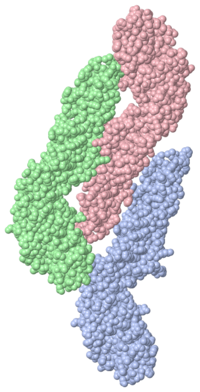Sandbox 1k4r
From Proteopedia
| Line 23: | Line 23: | ||
Dengue NS5 Protein<StructureSection load='2j7w' size='500' side='right' caption='NS5 polymerase (PDB entry [[2j7w]])' scene=''>The NS5 protein is a 900-residue peptide, which contains a methyltransferase domain. This protein plays an important role in the Dengue virus replication. The protein not only functions as a methyltransferase, but also as a RNA polymerase. The NS5 protein also contains guanylyltransferase activities, which, along with methyltransferase, help protect the viral genome and create efficient protein translation. | Dengue NS5 Protein<StructureSection load='2j7w' size='500' side='right' caption='NS5 polymerase (PDB entry [[2j7w]])' scene=''>The NS5 protein is a 900-residue peptide, which contains a methyltransferase domain. This protein plays an important role in the Dengue virus replication. The protein not only functions as a methyltransferase, but also as a RNA polymerase. The NS5 protein also contains guanylyltransferase activities, which, along with methyltransferase, help protect the viral genome and create efficient protein translation. | ||
| - | There are four serotypes of the Dengue virus, and the NS5 protein is most prominent in the Dengue-2-serotype, helping it with its pathogenesis.<scene name='56/565763/ | + | There are four serotypes of the Dengue virus, and the NS5 protein is most prominent in the Dengue-2-serotype, helping it with its pathogenesis. |
| + | Dengue-2 NS5 contains an also has an <scene name='56/565763/Sah/4'>active site</scene> which is considered a "S-adenosyl methionine-dependent methyltransferase fold" structure. The S-adenosyl methionine ligand is methylated in the methyltransferase domain, creating S-adenosyl-l-homocysteine (<scene name='56/565763/Sah/5'>SAH</scene>)as a by-product. | ||
| + | In the NS5 protein, there is another binding site for GTP. This binding of GTP is done in the N-terminal domain on the protein. The <scene name='56/565763/Active_site_gtp/3'>GTP in the binding site</scene> is to be a cap-binding site for the Dengue-2-methyltransferase. Overall the GTP is required for translation, transcription and replication processes.</StructureSection> | ||
Dengue NS3/NS2B Protein<StructureSection load='2vbc' size='500' side='right' caption='Structure of protease and helicase (PDB entry [[2vbc]])' scene=''>The NS3 protease is a serine protease that can also function as a RNA helicase and RTPase/NTPase. The enzymatic function of this protease is important for the Dengue virus to replicate. This enzyme of the virus is also a potential target for vaccines and antiviral drugs. | Dengue NS3/NS2B Protein<StructureSection load='2vbc' size='500' side='right' caption='Structure of protease and helicase (PDB entry [[2vbc]])' scene=''>The NS3 protease is a serine protease that can also function as a RNA helicase and RTPase/NTPase. The enzymatic function of this protease is important for the Dengue virus to replicate. This enzyme of the virus is also a potential target for vaccines and antiviral drugs. | ||
Revision as of 15:39, 5 November 2013
Contents |
Dengue Virus
| |||||||||
| 1k4r, resolution 24.00Å () | |||||||||
|---|---|---|---|---|---|---|---|---|---|
| Related: | 1svb | ||||||||
| |||||||||
| |||||||||
| Resources: | FirstGlance, OCA, RCSB, PDBsum | ||||||||
| Coordinates: | save as pdb, mmCIF, xml | ||||||||
Structure of Dengue Virus
The first structure of a flavivirus has been determined by using a combination of cryoelectron microscopy and fitting of the known structure of glycoprotein E into the electron density map. The virus core, within a lipid bilayer, has a less-ordered structure than the external, icosahedral scaffold of 90 glycoprotein E dimers. The three E monomers per icosahedral asymmetric unit do not have quasiequivalent symmetric environments. Difference maps indicate the location of the small membrane protein M relative to the overlaying scaffold of E dimers. The structure suggests that flaviviruses, and by analogy also alphaviruses, employ a fusion mechanism in which the distal beta barrels of domain II of the glycoprotein E are inserted into the cellular membrane.
Structure of dengue virus: implications for flavivirus organization, maturation, and fusion., Kuhn RJ, Zhang W, Rossmann MG, Pletnev SV, Corver J, Lenches E, Jones CT, Mukhopadhyay S, Chipman PR, Strauss EG, Baker TS, Strauss JH, Cell. 2002 Mar 8;108(5):717-25. PMID:11893341
From MEDLINE®/PubMed®, a database of the U.S. National Library of Medicine.
Etiology
Dengue virus is a mosquito borne illness and is a major threat in most of the tropical and sub-tropical countries around the world. There are four related subtypes of the Dengue virus. Dengue is not transmitted directly from person-to-person and symptoms range from a mild fever, to incapacitating high fever, with severe headache, pain behind the eyes, muscle and joint pain, and rash. There is no vaccine or any specific medicine to treat dengue. People who have dengue fever should rest, drink plenty of fluids and reduce the fever using paracetamol or see a doctor.
About this Structure
Dengue Virus inside Cell
| |||||||||||
| |||||||||||
| |||||||||||
Reference
- Kuhn RJ, Zhang W, Rossmann MG, Pletnev SV, Corver J, Lenches E, Jones CT, Mukhopadhyay S, Chipman PR, Strauss EG, Baker TS, Strauss JH. Structure of dengue virus: implications for flavivirus organization, maturation, and fusion. Cell. 2002 Mar 8;108(5):717-25. PMID:11893341
Categories: Dengue Virus | RCSB PDB Molecule of the Month | Viruses | Baker, T S. | Chipman, P R. | Corver, J. | Jones, C T. | Kuhn, R J. | Lenches, E. | Mukhopadhyay, S. | Pletnev, S V. | Rossmann, M G. | Strauss, E G. | Strauss, J H. | Zhang, W. | Dengue virus | Flaviviridae | Flavivirus | Glycoprotein e from tick-borne encephalitis virus | Icosahedral virus | Virus


